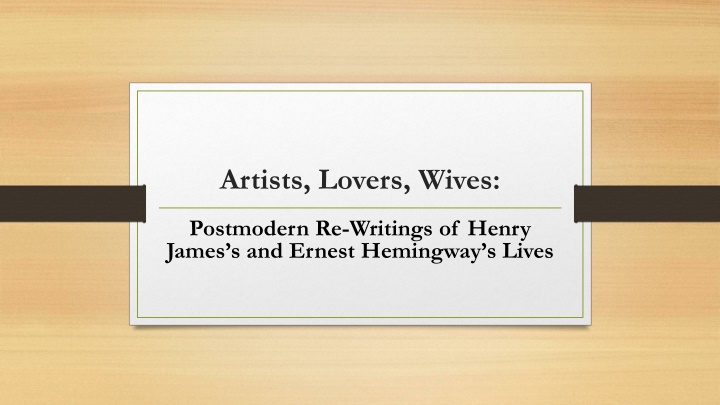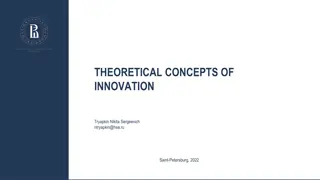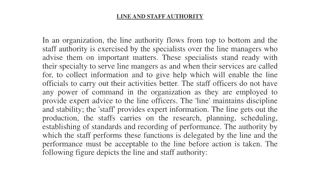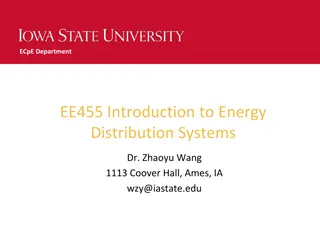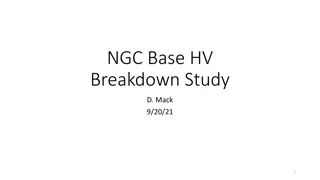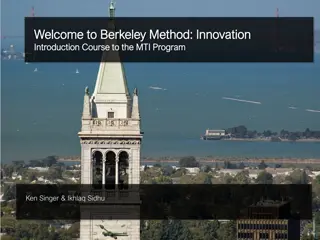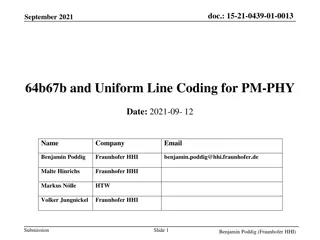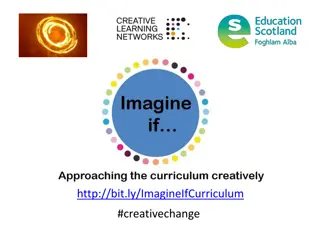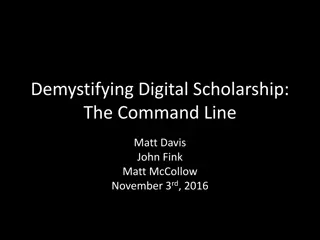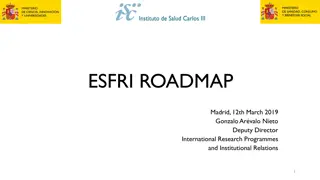On-Line Research Co-op: Sparking Innovation and Collaboration
"The On-Line Research Co-op Program offers high school seniors unique opportunities to engage with national academics and R&D teams, enhancing their skills in e-communication, problem-solving, and collaboration. Students participate in remote research projects, earning academic credit and potential scholarly publications. This cyber format program eliminates commuting constraints, making it ideal for busy high school students in specialist programs. Through teacher recommendations and student interests, candidates select research fields and connect with mentors to work as research assistants. The program culminates in the chance to publish findings in the Canadian Young Scientist Journal."
Download Presentation

Please find below an Image/Link to download the presentation.
The content on the website is provided AS IS for your information and personal use only. It may not be sold, licensed, or shared on other websites without obtaining consent from the author.If you encounter any issues during the download, it is possible that the publisher has removed the file from their server.
You are allowed to download the files provided on this website for personal or commercial use, subject to the condition that they are used lawfully. All files are the property of their respective owners.
The content on the website is provided AS IS for your information and personal use only. It may not be sold, licensed, or shared on other websites without obtaining consent from the author.
E N D
Presentation Transcript
Artists, Lovers, Wives: Postmodern Re-Writings of Henry James s and Ernest Hemingway s Lives
Introduction Biographical fictions underline the connection between fiction, biography and autobiography by delivering texts that are both intensely self-reflexive and yet paradoxically also lay claim to historical events and personages (Hutcheon, 1988: 5). The creative process involves different appropriations of facts, fictional characters, novels, literary practices and motifs making it an increasingly popular practice of contemporary fiction. The poetics that is developed alongside these novels helps to enquire into the critical and historical contexts of the works as well as the intricate interactions between fact and fiction resulting into diverse correspondences between past and present. Therefore, some points of the postmodern poetic vein will be used to observe and question how the biographical fiction is (or could have been) made. The analysis is situated within the lives and context of two great American writers, Henry James and Ernest Hemingway as represented in The Typewriter s Tale by Michael Haynes and Hemingway s Girl by Erica Robuck. The differences and the alignments of the novelistic representation of real and fictional characters and events in the two biofictions as well as their individual peculiarities are of special concern. The authors own works and documented personal reflections are committed to presenting their lives in specific ways resulting in a literary text that can be critically explored as a metiaficiton. The word postmodernism immediately brings to mind notions of fracturing, fragmentation, indeterminacy, plurality and it involves all of them. As such, postmodernism itself is fragmentary and fracturing. (Malpas 2005:6) ) In the postmodern literary text, notions of originality and authenticity are undermined and parodied by using old literary forms, genres, and kinds of literature and art such as kitsch, quotation, allusion and other means to recontextualize their meaning in a different linguistic and cultural context.
The postmodern authors ask the readers for their active participation. Their willing suspension of disbelief is no longer required and they do not have to be passively involved into the fictitious world of the postmodern, nor does it completely resemble the real world. What novelists do is exploring contingent reality and not a structured order. For Hutcheon, the combination between historiography and metafiction is what completes the poetics of postmodernism. Historiographic entails the critical interest in history and the writings of history. What historiographic metaficition does is using metaficition to underscore the construction of history producing a literary artifact. It draws attention that past is understood by texts, and texts of historical sources are intertextual. The world and reality are understood by the products of culture. Its cultural representations in the narratives is what makes our knowledge of the world and so postmodernism turns to one of its fundamental techniques, the intertextuality. The intertextual parody shows the world and its past as seen in its texts. Past is still incorporated in the present but parodically questioned. Readers of biographical fiction approach the work with previous knowledge on the subject. Anyone who decided to read a novel that features the names of Henry James or Ernest Hemingway possesses certain notions on the subject and therefore, their response to reading and understanding the work is uniquely premeditated. The literary schemata is confronted with the authors choices in the creation of historiographic metafiction. How can possibly an employee as typewriter can or a young housemaid have any significant influence on the authors lives?
The Typewriters Tale and Hemingways Girl A postmodern literary work questions but does not reject its own fictional status and thus becomes metafictional. Metafictional means that a literary work refers to itself and the principles of its construction by using various techniques and narrative devices (Ku n r: 2011 Chapter 3). Neither of the novels is seemingly solely about the authors. The Typewriter s Tale features the affairs around Frieda Wroth, the typewriter Henry James hires as typist to help him prepare the revised New York edition of his works. Hemingway s Girl tells the story of Hemingway s house maid, the 19- year old Mariella Bennet during the 1930s in Key West where he lives with his second wife Pauline Pfeiffer. So what are their roles as fictional characters in the creation of the different authorial figures? Are they servants, employees, friends or lovers? Frieda Worth is a woman whose story revolves during the first decade of the twentieth century. In James s employment she goes through the most important aspects in her personal and professional growth and development when she meets the people from the author s surrounding in Rye. In many biofictions, often real historical characters meet with fictional characters or the characters from different historical periods meet in the fictional present, or real historical figure is depicted in the fictional situation which causes an ontological issue. These characters and worlds often merge and express uncertainty, relativity and confusion. It evokes a metafictional effect implying the idea that the literary work is also a work on the working of language in a literary work. The idea is that the language is not a self-enclosed system dependent on the context and its use in particular situations and the language is thus presented as unstable relative and manipulated.(Ku n r: 2011 Chapter 3). Frieda Wroth is based on James s typewriter Theodora Bosanquet who works for him from 1907 until his death in 1916. She meets Morton Fullerton, the author s old friend on his brief visit travelling from America to Paris. Her meeting with him at the Burlington Hotel is very daring at the time as is her position of having to made choices that can have many consequences on the others. Her character is used to voice Fullerton s thoughts, as she is the one who is typing the story but also through a medium that is supposed to transfer his thoughts when he is away. The other guest stars also involve actual historical figures, such as Hugh Walpole and Edith Wharton who are given specific role to force the action.
The Typewriters Tale and Hemingways Girl Postmodern authors intentionally build the meaning by using the old forms and genres deliberately turning to plagiarism, kitsch, false or pretended quotations from well-known literary and other texts. Plagiarism is not meant to steal the authors ideas but to evoke parody effect and ironic distance from these texts. The idea is creative reuse and recontextualisation of already existing texts by means of linguistic and textual play. The postmodern play allows for presentation of facts taken out of context which can in turn be manipulated by not allowing an alternative view of the same event. This leads to a significant aspect of postmodern culture and the vision of the world the postmodern literature often formally expresses and thematizes, that is a manipulation through the overlapping of the fact and fiction, reality and fantasy (Ku n r: 2011 Chapter 3). Henry James is especially noted for his specific chewing of the food while eating as well as his brother and sister-in-law adopting that habit. His niece is also portrayed as a particular member of the family both in light of her own character and as a rich American inclined to believe contacts from people who are not present or who are deceased. Fullerton s historical context of having many relationships with different girlfriends, the urban Henry James and the flamboyant Edith Wharton are recontextualised by means of the wise observer, Frieda Wroth. The alluring Fullerton seduces Frieda and proposes her to steal the letters he sent Henry James, offering her a visit to Paris with him. Thus, Frieda gets involved with her master and her lover Fullerton in a whole different light. Postmodernist parody, be it in architecture, literature, painting, film or music uses its historical memory, its aesthetic introversion, to signal that this kind of self- reflexive discourse is always inextricably bound to social discourse (Hutcheon 1988: 35)
The love triangle that occurs between Freida, Fullerton and Wharton is parodied in the postmodern mode. The whole creating of the typewriter s viewpoint on the characters relations is parodically subverted. In difference to traditional parody, postmodern parody does not mock the parodied author or style for its own sake, but this parody lacks this mocking, ridiculing aspect and by adding irony it emphasizes a difference between the past forms of art and sensibilities, a distance between the past and present. In this respect, parody and irony in postmodern literature are very closely connected or almost inseparable. (Hutcheon 1991:228). The character of Frieda is a postmodern character through which Heynes is triggering and shuffling the intrigues surrounding Henry James and his dear friends and family. She is a representation of a modern woman struggling to go through love, redemption and sacrifice. Much in the same vain is introduced Mariella Bennet. She is a young woman in service of a great author about 30 years later. Her story is geographically and historically set in specific period of Hemingway s life. According to Hutcheon, What historiographic metaficition does is using metaficition to underscore the construction of history producing a literary artifact. It draws attention that past is understood by texts, and texts of historical sources are intertextual. The world and reality are understood by the products of culture. Its cultural representations in the narratives is what makes our knowledge of the world and so postmodernism turns to one of its fundamental techniques, the intertextuality. The intertextual parody shows the world and its past as seen in its texts. Past is still incorporated in the present but parodically questioned.
Hemigway s Girl involves geographical knowledge about Key West and cultural myths connected with specific places. Robuck makes use of the historical facts such as the building of the highway through the Keys and the hurricane of 35. Her narrative as a cultural construct comes to terms with time, process, and change. This is a strategy that contrasts with, but is in no way inferior to, scientific modes of explanation that characterize phenomena. Nevertheless, narrative and science are interdependent. Narrative techniques are used to make account of some scientific event or discovery as much as scientific tools are used for narrative analyses of a text, discourse or a film, a narrative. Herman s empirical approach based on intuition and narrative scholarship offers a possible model of a narrative. Firstly, he states that individual recounts form a story followed by future projections and an evaluated report. It is considered the prototype of a narrative activity. According to Herman, stories can be analysed in four basic elements, all of which entail sub-elements of their own. He characterizes the narrative as situated and interpreted in the light of specific discourse context or occasion of telling. This mode of representation (ii) focuses on a structured time-course of particularized events. In addition, the events represented are (iii) such that they intro- duce some sort of disruption or disequilibrium into a storyworld, whether that world is presented as actual or fictional, realistic or fantastic, remembered or dreamed, etc. The representation also (iv) conveys what it is like to live through this storyworld-in-flux, highlighting the pressure of events on real or imagined consciousness undergoing the disruptive experience at issue. As noted previously, for convenience of exposition these elements can be abbreviated as (i) situatedness, (ii) event sequencing, (iii) worldmaking/world disruption, and (iv) what it s like (Herman 2008:9). The writing technique of the Typewriter s Tale is that of a wordsmith typing a story as if their own, and the end marks the beginning of the typing of Freida s novel. Robuck story picks up in 1961 soon after Mariella finds out about Hemingway s suicide and goes back to the 30s of Key West and the year they spend together. Her use of season change is symbolic of the process of Mariella s growth and understanding, following the summer on the island Bimini culmination with the 1 September 1935 hurricane attack. In 1934 he bought a boat, named it the Pilar and began sailing in the Caribbean. In 1935 he first arrived in Bimini.
Generally speaking, all metafictional self-reflexivity and auto-representation act to question the very existence as well as the nature of extratextual reference. However, historiographic metafiction complicates this questioning. History offers facts interpreted, signifying, discursive, textualized made from brute events. Is the referent of the historiography, then, the fact or the event, the textualized trace or the experience itself? Postmodernist fiction plays on this question, without ever fully resolving it. It complicates the issue of reference in two ways, then: in this ontological confusion (text or experience) and in its overdetermination of the entire notion of reference (we find autoreferentiality, intertextuality, historiographic reference and so on). There is a tension, then, not only between the real and the textualized, but also among a number of kinds of reference. The shabby treatment of the WWI veterans in the time of the Depression during the 30. Hemingway s article as a firsthand account of the hurricane, when a great number of vets and their families lost their lives is also included in the story. It is used to add to the new meaning created in the story of Mariella. The characters search, however, often become symbolic search for meaning, objectivity and truth which can never be achieved and which manifests itself within the allegorical framework. The symbolic quest and meaning are disseminated throughout the text and finally pass into postmodern allegory within which the following issues are treated: the relationship between the author, the literary work and the reader, between life and art, a difference between real experience and its artistic (linguistic representation), the nature of reality and fiction, that is ontological issues, such as the nature and the process of creative writing. In postmodern literary work, a mimetic, realistic representation often overlaps with fiction, fantasy, dreams and sometimes hallucinations and in difference from modernist literary works, it is difficult to distinguish between these spheres and ontological levels.(Ku n r: 2011 Chapter 3).
In it there are two love triangles, Hemingway playing central part in both of them. The first one between Mariella, Hemingway and Gavin is used to illuminate Hemingway s figure as a rich successful author, extremely charismatic, but also married for the second time, as opposed to Gavin, a down- to- earth, honest ex-soldier. Despite their different socio economic status they are very similar and Mariella s attraction is used to emphasize their contrasting figures. Gavin like Hemingway, also took part in the WWI and like him he also enjoys boxing but he lacks Hemingway s literary fame. Robuck puts Hemingway s lady man s figure as an extravagant personality of a in the shade of his counterpart, Gavin. The other love triangle produces yet another meaning to contrast previous events in the author s life. Pauline, a woman known to have stolen Hemingway from his first wife, becomes insecure at the backdrop of the Hemingway Pauline Hadley triangle further emphasized by the presence of Jane. Both Hemingway and Pauline are put on a fictional test. It is a question of how they would both react in the appearance of another woman. Robuck juxtaposes different categories of the era: the indulgent extravagance of the Hemingways in contrast to the hardships of WWI veterans is as fascinating as it is heartbreaking. She is generating meaning from brute events by spicing a historical act. The household drama is coupled with the desolate plight of the veterans. Another postmodern juxtaposition is the socio-economic status of Mariella as half Cuban half American and her identity as such.
The epistolary aspect in both The Typewriters Tale and Hemingways Girl embodies truth and honesty and thus metafctionally functions as parodical pastiche. The exchange of letters continues the resolution of the love triangles. Neither Hemingway nor Mariella cut the ties between them. It means that although Hemingway wrote letters extensively in his life he would maintain the communication between them, and so does Mariella. Some of the letters in The Typewriter s Tale are the original, while others neatly voice the characters language and style. The burning of the letters which are at the heart of the intrigue actually happens. It concludes the story and marks the moment when Frieda ends her two-year involvement in it.
Conclusion According to Hutcheon, contemporary self-reflexive, discontinuous, and often difficult historiographic metafiction does is work to subvert the view of history as a coherent inscription of unified subjectivity. In historiographic metafiction the subversion of the stability of point of view takes to forms. On the one hand, there are overt manipulative narrators; on the other, no one single perspective but myriad voices, often not completely localizable in the textual universe. In place of anonymity we find over assertive and problematizing subjectivity and a pluralizing multivalence of points of view. Both plots are plausible as fiction revealing the aesthetic, stylistic and creative choices the authors made. Two women three decades apart recount their stories of how they relate to the important men in their lives. It would all be simple and pretty straightforward if it hadn t been for incursion of actual historical facts and events from the lives of the great American authors Henry James and Ernest Hemingway.
